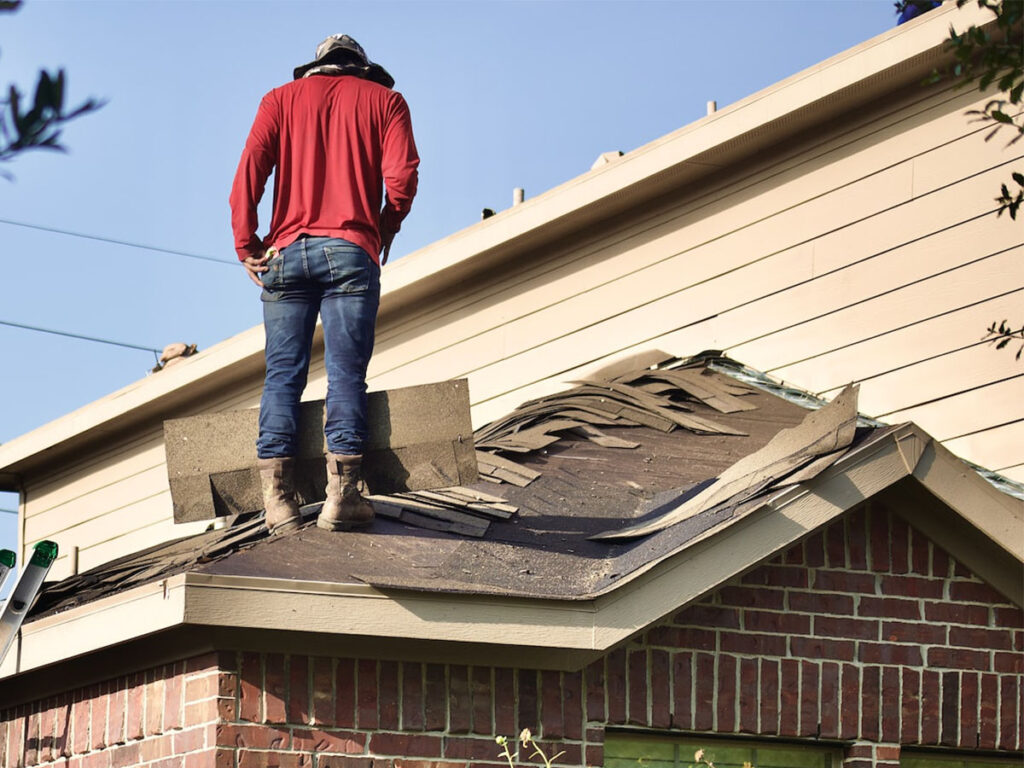Table of Contents
Key Takeaways✔ Brown spots, peeling paint, or musty smells inside the home are clear signs of water stains or leaks that indicate urgent roof issues requiring professional attention. ✔ Cracked, curled, or missing shingles expose your roof to water and UV damage, often pointing to underlying structural problems that need expert inspection. ✔ A roofline that appears sagging or uneven can be a structural red flag, signaling weakened supports that must be evaluated before further damage occurs. ✔ When shingles start showing bald patches and losing granules, it’s a strong indicator that the roof is deteriorating and may no longer provide adequate protection. ✔ If your roof is aging and constantly needs fixing, it’s likely approaching the end of its lifespan and may be more cost-effective to replace than to keep repairing. |
A home’s roof is its primary defense against the elements. When compromised, it can threaten everything from insulation and structural safety to air quality. Recognizing the early signs of roof damage and calling in a licensed roofing contractor can prevent minor issues from evolving into costly disasters.
Here are the top five signs it’s time to seek professional residential roof repair services.
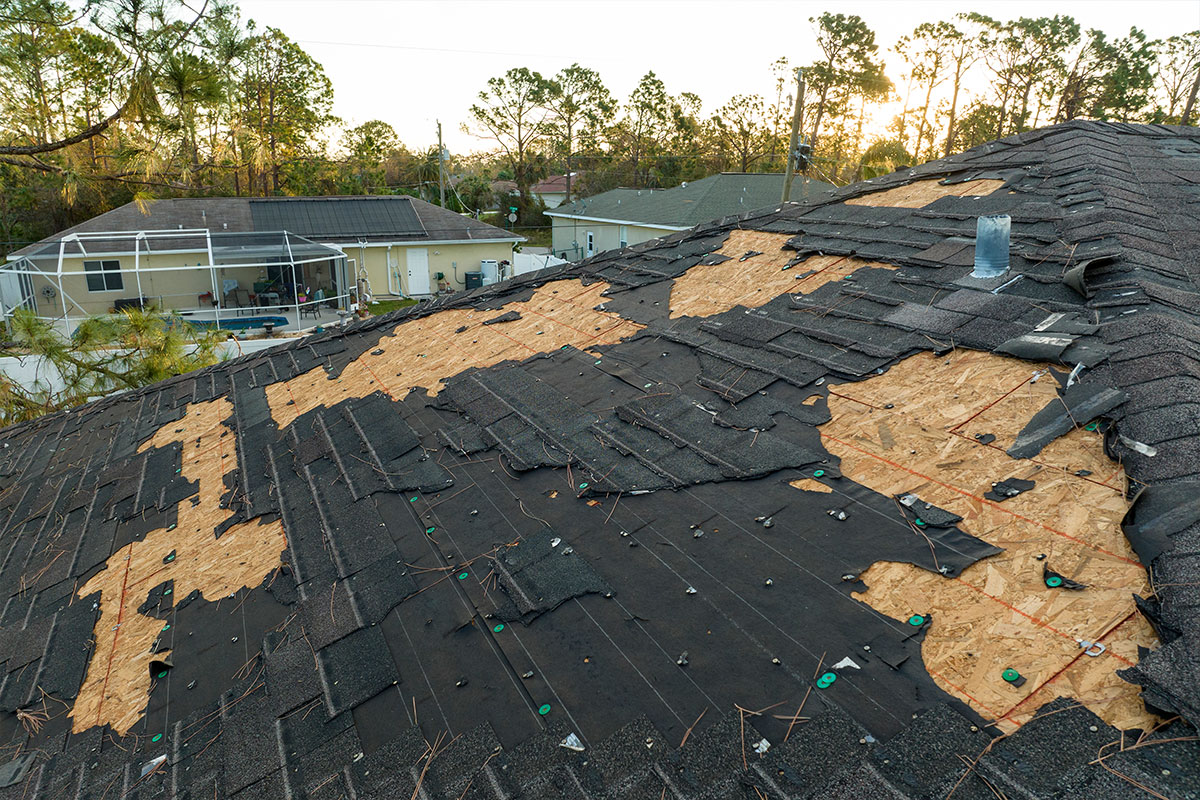
1. Persistent Leaks or Water Stains Indoors
Water intrusion is often the first noticeable sign of roof failure—and one of the most serious. Ignoring it can compromise both your home’s structure and the health of its occupants. When simple caulking or sealant won’t fix the issue, residential roof repair services step in with permanent solutions such as flashing replacement, shingle repair, or targeted roof membrane restoration.
Common Warning Signs
- Brown or yellow stains on ceilings or walls: These indicate slow leaks that may have been occurring for weeks or even months.
- Peeling paint or bubbling drywall: Moisture trapped behind surfaces often causes materials to warp or detach.
- Damp or musty odors near attic spaces: Lingering smells often point to hidden mold or mildew forming inside insulation or wood beams.
- Visible drips during heavy rain: Active leaks are often seen around chimneys, vents, skylights, or recessed lighting fixtures.
Non-Visible Signs of Water Stain
- Mold growth, which can trigger allergies and respiratory issues.
- Rotting of rafters, trusses, or joists, weakening the home’s frame.
- Electrical hazards, especially if leaks are near outlets or junction boxes.
Tools and Techniques A Licensed Roofing Contractor Use
- Infrared thermal imaging to locate hidden damp spots behind walls and ceilings.
- Attic inspections to assess insulation, decking, and ventilation conditions.
- Leak path tracing to pinpoint where water enters and how it travels inside the home.
2. Damaged or Missing Shingles
Shingles are the outermost layer of protection for a roof. Once damaged, the rest of the roofing system is exposed to water, wind, and UV radiation. Since the expected lifespan of asphalt shingle roofs is 15 to 30 years, widespread damage or frequent repairs may indicate that your roof is reaching the end of its service life—making it time for a deeper inspection by certified roof installation experts.
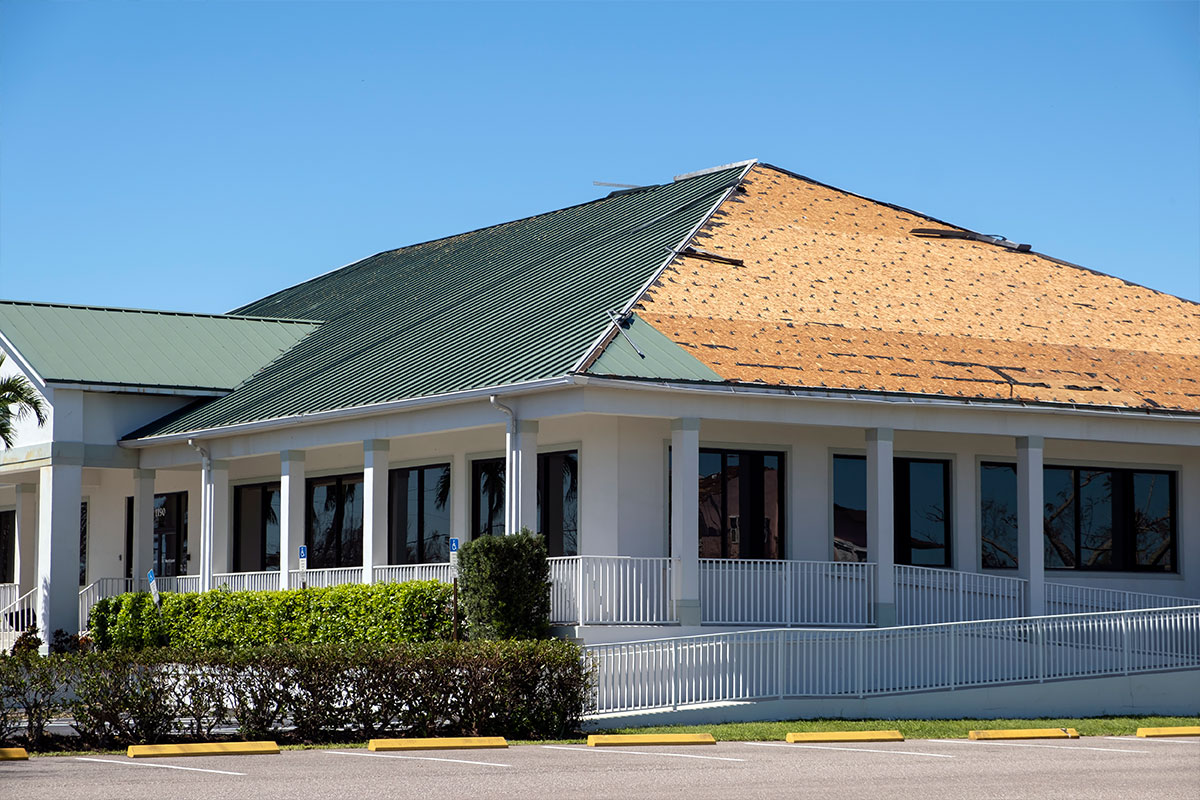
Visible Signs of Shingle Damage
- Bare or exposed patches: Missing shingles leave the underlayment and decking exposed to rain and sun.
- Loose granules in gutters or at downspouts: Granule loss reduces a shingle’s ability to reflect UV rays and resist water.
- Edges that curl upward or corners lifting: This often indicates aging materials or poor ventilation beneath the shingles.
- Discoloration or inconsistent patterns: Shingles that fade or darken unevenly may be deteriorating at different rates.
What Damage Indicates
- Improper ventilation, which accelerates wear.
- Subsurface water damage, hidden beneath the visible surface.
- Failing flashing, which allows moisture to enter around roof penetrations.
What a Licensed Roofing Contractor Provides and Ensures
- Full-roof assessments, identifying damage not visible from ground level.
- Material matching, ensuring replaced shingles blend in seamlessly for both performance and appearance.
- Inspection of critical joints, such as chimneys, vents, valleys, and eaves, where damage is often more severe.
- Safety, especially when working on steep or high-pitched roofs.
- Proper installation, reducing the risk of further damage.
- Warrantied work, offering peace of mind and long-term protection.
3. Sagging or Uneven Roof Surface
A sagging or misshapen roof is a serious structural warning sign. While it may start as a subtle dip or bend, this issue often points to deeper failures within the roofing framework. Unlike surface-level damage, sagging affects the integrity of the entire structure and must be addressed promptly. Delaying action can dramatically increase repair costs and risk. That’s why it’s essential to contact an emergency roofing contractor at the first sign of sagging.
Common Causes of Roof Sagging
- Waterlogged decking: Moisture trapped beneath the shingles can saturate the wood sheathing, causing it to weaken and droop over time. This often results from slow leaks or poor attic ventilation.
- Broken or compromised rafters/trusses: Rafters and trusses support the entire roof structure. If cracked, rotted, or split, they can no longer bear the roof’s weight, causing visible sagging.
- Excessive weight from debris or ice dams: Accumulated snow, fallen branches, or clogged gutters can overload the roof. This added stress often leads to bending, especially if the roof was not built to handle such loads.
- Poor design or substandard construction: Inadequate spacing between trusses or the use of undersized materials can lead to long-term performance issues. DIY work or low-quality construction methods often manifest as sagging within a few years.
- Aging materials and settling: In older homes, roofing materials can deteriorate, and structural supports may shift slightly, causing uneven slopes or depressions.
Why Sagging Is Dangerous
- Structural instability: A sagging area indicates that weight is not being properly distributed. This imbalance can lead to partial collapses or cause nearby sections to weaken.
- Hidden moisture damage: Even if leaks aren’t visible, sagging areas often retain moisture, increasing the risk of rot, mold, and insulation damage.
- Worsening over time: Without professional intervention, sagging worsens with each storm or snowfall. What starts as a shallow dip can quickly evolve into a roof-wide failure.
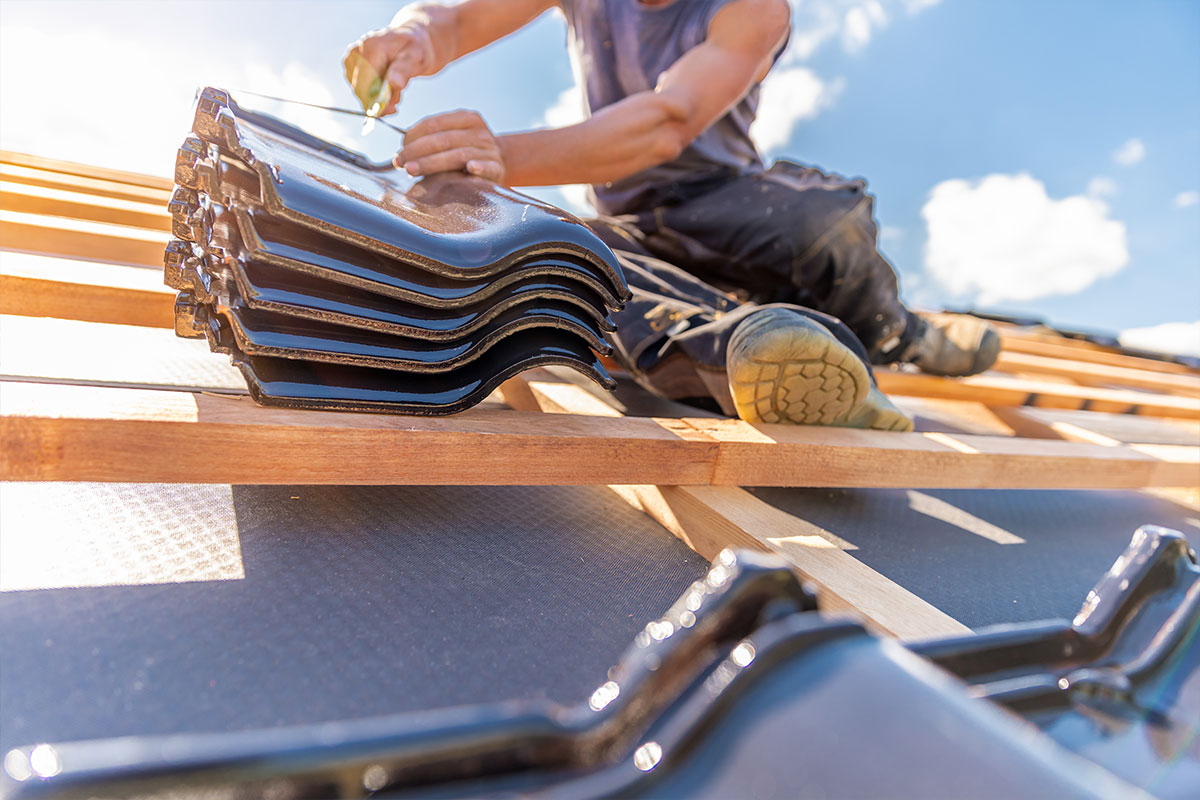
What a Licensed Roofing Contractor Will Do
- Conduct a structural assessment: Using tools like moisture meters and infrared imaging, a licensed roofing contractor identifies the root cause and extent of the damage.
- Determine the scope of repairs: Some cases may only require reinforcement in specific areas. Others demand partial or full roof replacement depending on the damage and age of the materials.
- Ensure code compliance and load-dearing safety: Professionals follow local building codes and calculate load-bearing needs to avoid future failures.
- Recommend material and design upgrades: Roof installation experts may suggest upgrading to lighter or more durable materials, especially for regions with heavy snowfall or extreme weather.
When to Call an Emergency Roofing Contractor
- If you notice a sudden dip after a storm
- If ceiling cracks or wall separations start appearing inside
- If rooflines appear visibly uneven from the street
- If you hear creaking or popping sounds from the attic
4. Excessive Granule Loss or Bald Shingles
Shingles are topped with mineral granules that serve critical functions—they reflect UV rays, increase durability, and help shed water efficiently. When these granules wear off in large amounts, it’s a warning that the shingles—and possibly the entire roof—are deteriorating beyond safe limits. Quick action can prevent widespread damage and extend the roof’s life.
Key Indicators of Granule Loss
- Granules in gutters and downspouts: A noticeable buildup of sand-like particles in drainage systems signals active shedding, especially after storms or high winds.
- Shiny, smooth patches on shingles: These “bald” areas expose the asphalt base, making the shingles vulnerable to heat, water, and impact damage.
- Discoloration or dark streaks on the roof surface: Uneven granule wear causes aesthetic changes that often point to accelerated aging.
- Debris buildup around roof edges: Excess granule loss can mix with dirt and clog drainage paths, compounding roof stress.
Why It’s a Serious Concern
- Reduces UV protection: Without granules, shingles absorb more heat, increasing attic temperatures and utility costs.
- Decreases water resistance: Bald shingles retain water, promoting faster deterioration and a higher risk of leaks.
- Weakens the overall roof structure: Over time, degraded shingles compromise the underlayment and decking below.
How a Licensed Roofing Contractor Helps
- Pinpoint the cause of granule loss: Whether due to age, poor installation, or defective materials, a licensed roofing contractor identifies the root issue.
- Differentiate between natural aging and failure: Not all granule loss signals a crisis, but excessive shedding does. Professionals can tell the difference.
- Recommend advanced roofing materials: The best residential roofing contractor has access to upgraded shingles that offer superior UV resistance, longer life spans, and better performance under extreme conditions.
- Install with manufacturer-backed warranties: Proper installation by certified roof installation experts preserves warranties that protect your investment.
5. Old Age or Recurring Repairs
Even the most well-maintained roof has an expiration date. In fact, demand for new residential roofing is expected to increase as single-family housing starts to rebound, following two years of decline after the surge in 2021. This trend underscores the importance of staying proactive—aging roofs are more likely to be replaced as part of this growth, and delaying action may lead to longer wait times or higher costs.
Typical Lifespans by Roofing Material:
- Asphalt shingles: 15-30 years
- Metal roofing: 40–70 years
- Wood shake: 20–30 years
- Slate or clay tile: 50+ years
Signs Your Roof May Be at the End of Its Life
- Frequent repair needs: If you’ve already patched leaks, replaced shingles, or re-flashed the chimney multiple times, it likely indicates systemic wear.
- Increased storm damage: Older roofs struggle to withstand wind, hail, and heavy rain due to weakened materials and worn seals.
- Widespread surface wear: Curling edges, cracking, or algae growth over large areas point to aging materials that no longer function properly.
- Sagging or soft spots when walked on: Structural materials beneath the shingles may be compromised due to long-term moisture exposure.

Why Aging Roofs Need Professional Evaluation
- Hidden issues beneath the surface: Rotting decking, degraded underlayment, and mold are often invisible from the ground but may pose serious risks.
- Accumulated damage over time: Years of UV exposure, temperature fluctuations, and minor leaks can add up, even if previous repairs were done correctly.
- Cost-effectiveness of replacement: Continual repairs eventually become more expensive than a full replacement. A licensed roofing contractor helps assess this tipping point.
What a Residential Roof Repair Services Provider Will Do
- Conduct a full-scope inspection: Professionals inspect attic ventilation, moisture levels, insulation, and roof structure to gauge overall condition.
- Provide future-focused solutions: Provide future-focused solutions: Rather than just patching issues, the best residential roofing contractor will recommend material and design upgrades that offer long-term value.
- Support homeowners through urgent repairs: An emergency roofing contractor can handle immediate risks, like storm damage, while creating a plan for full replacement if necessary.
When to Consider Full Replacement
- The roof is approaching or beyond its expected lifespan
- You’re spending money on repairs more than once a year
- The roof fails to pass a professional inspection
- You’re planning to sell your home and want to boost property value
How to Choose the Right Licensed Roofing Contractor
Not all roofing professionals are equal. Choosing the right provider ensures quality, safety, and lasting value. Here’s how homeowners can identify the right licensed roofing contractor in Pleasant Valley, NY, for the job:
1. Verify Licensing and Insurance
The contractor must hold a valid license in the state or municipality. This ensures they meet local codes and industry standards. Insurance is equally important—it protects both the homeowner and the crew. A reputable emergency roofing contractor will carry liability and workers’ compensation coverage.
2. Check Reviews and References
A history of satisfied customers is a strong indicator of reliability. Read online reviews, check Better Business Bureau ratings, and ask for references. A trustworthy licensed roofing contractor should provide contact information for past clients who can speak to their experience.
3. Evaluate Experience and Specialization
Some contractors specialize in commercial roofing, others in residential. Homeowners should seek the best residential roofing contractor with a proven track record. Ask how long they’ve been in business, whether they work with specific roofing materials, and if they’re certified by manufacturers.
4. Demand Written Estimates and Contracts
Transparency is key. A professional should offer a detailed written estimate, outlining materials, labor, timelines, and warranties. Contracts should clearly state payment schedules, project scope, and any contingencies.
5. Ask About Warranties
A reliable licensed roofing contractor will offer both manufacturer warranties on products and workmanship guarantees on labor. This double protection ensures that if anything goes wrong, the homeowner won’t be left to shoulder the costs.
6. Assess Communication and Professionalism
Responsiveness, punctuality, and clarity are signs of professionalism. From the first call to the final inspection, the roof installation experts should provide updates and answer questions. Poor communication is often a warning sign of future issues.
Frequently Asked Questions
A legitimate roofing contractor should have a valid license, proof of insurance, and a physical business address. You should also check online reviews, references, and ratings from trusted sources like the Better Business Bureau. Legitimate contractors provide written estimates, contracts, and warranties, and are transparent about pricing and timelines.
Some “free roof” programs are legitimate, typically tied to insurance claims, nonprofit assistance, or manufacturer promotions. However, others may be scams or marketing tactics that involve hidden fees or bait-and-switch schemes. Always research the company, read the fine print, and confirm the source of funding before committing to any free roof offer.
A roofing contract may be voided if terms are breached, such as missed payments, unauthorized changes to the scope of work, or failure to comply with local building codes. Additionally, using unapproved materials or failing to meet permit requirements can also nullify the agreement. It’s important for both parties to follow all conditions outlined in the contract to maintain its validity
If a roofer performs substandard work, start by documenting the issues with photos and written descriptions. Contact the contractor to discuss your concerns and request corrections per the warranty or contract terms. If they refuse or ignore you, file a complaint with your state’s licensing board, local consumer protection agency, or consider legal action if necessary.
Homeowners’ insurance often covers roof repairs or replacement if the damage is caused by a covered peril like hail, wind, or falling trees. However, it typically won’t cover wear and tear, neglect, or issues from poor maintenance. It’s essential to review your policy, document the damage, and file a claim promptly to improve your chances of approval.
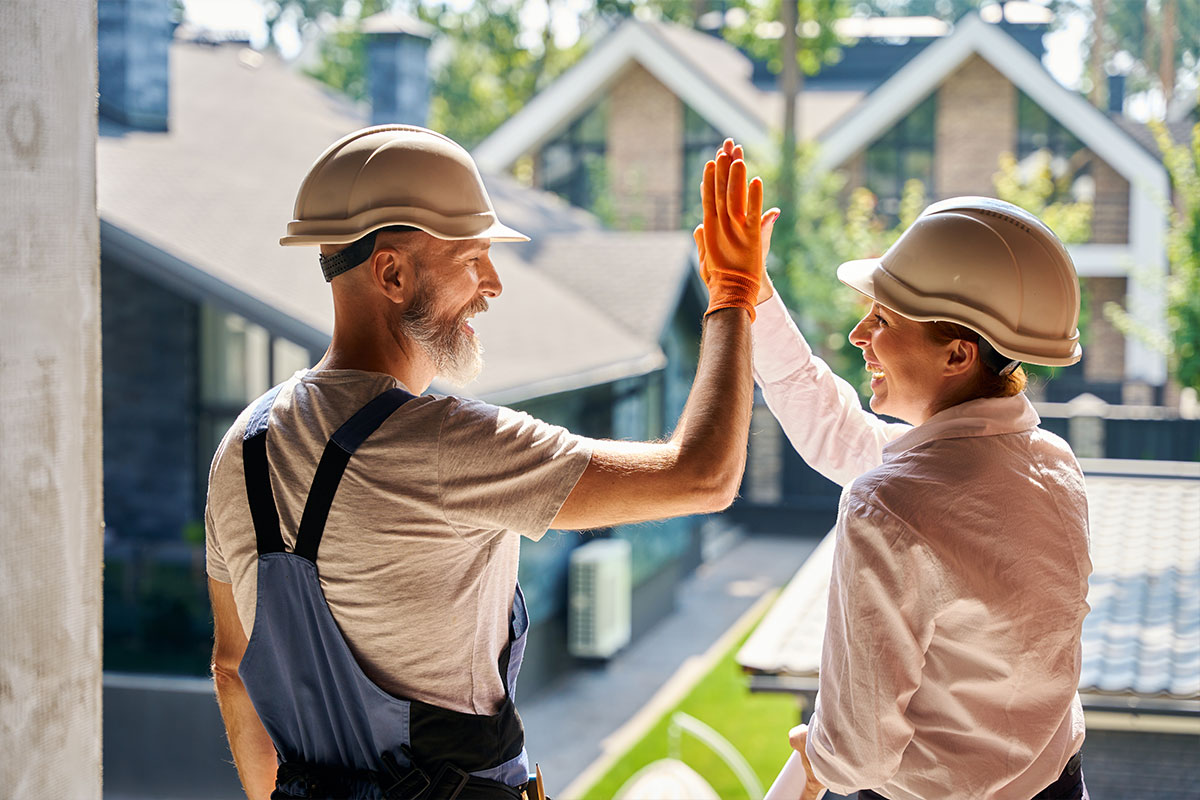
Protect Your Home—Call Roofer of Pleasant Valley Today!
If you’ve noticed any of these warning signs—whether it’s leaks, damaged shingles, or a sagging roof—don’t wait for the damage to spread. Contact Roofer of Pleasant Valley for fast, professional service backed by licensed expertise. As the trusted choice for Pleasant Valley, NY, residents, Roofer of Pleasant Valley delivers top-quality inspections, repairs, and full replacements that are built to last.
Serving Pleasant Valley, NY, with pride, Roofer of Pleasant Valley is committed to keeping your home safe, dry, and structurally sound. Whether you need urgent repairs or a long-term solution, our experienced team is ready to help!

